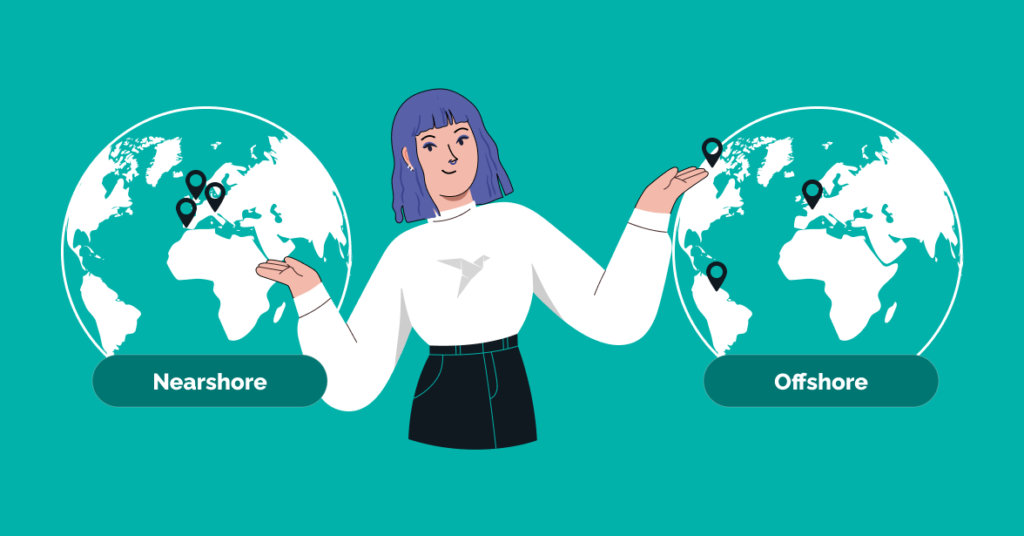The demand for software development is ever increasing and it is likely to only accelerate in the coming years. In such a competitive and intensive market scenario, businesses are faced with a crucial decision as to how to execute their project efficiently. Should they hire in-house developers? Should they outsource their project to dedicated teams? What are the different outsourcing options? What is the difference between onshore and offshore development models?
If you are reading this blog, chances are you have these questions for your organization as well. And you’re at the right place as we are going to decode the differences between the two most popular outsourcing models – onshore and offshore, as well as compare it to hiring in-house developers so you know which model is the right choice for your business needs.
What is Outsourcing?
Outsourcing is the process of delegating specific business/technical tasks or processes to external service providers instead of asking your in-house team to handle it. The reason to outsource your project to a third-party vendor over in-house team can me many. Some of them are –
- Cost Efficiency
- Access to Specialized Skills
- Scaling & Descaling Flexibility
- Time Efficiency
- Ability to Focus on Core Competencies
- Global Market Reach
- Round-the-Clock Operations
- Faster Turnaround Time
Now there are three essential outsourcing models that you should know of –
- Onshore Model: Hiring external developers from the same city/country/timezone.
- Nearshore Model: Hiring external developers from different country, same or similar timezones.
- Offshore Model: Building your offshore development center at far off countries like India, Singapore, Ukraine and more with differing time zones.
What is Onshore Development Model?
Onshore development is when the client and the service provider reside in the same country or at times even the same city. This model emphasizes on close collaboration between the outsourced development team and the client and is generally ideal for clients that want active participation in the team’s daily operations, want better control and ease of access to meet the team and where their contributions are required on a daily basis.
Pros of Onshore Development
Onshore Development Model comes with many benefits, some of which are pretty obvious such as better accessibility to the team. Let’s dive deeper to evaluate all the benefits you can avail with onshore development model –
Cultural Compatibility – Onshore developers are basically developers hired from external sources instead of hiring them in-house. This means these developers are more likely to share the same cultural believes and practices which would make their onboarding and collaboration with in-house team much smoother with less-to-none communication barriers.
Time Zone Convenience – Working hours or real-time collaboration won’t be an issue since onshore team would work on the same hours as your in-house team which would enable quicker decisions and real-time discussions.
Quality and Accountability Control – Since the development team is going to be right under your nose, you would be able to implement and check for work quality and hold developers accountable for their actions by keeping a keener eye on the entire work progress. This would allow more project transparency and better deliverables.
Limitations of Onshore Development
Yes, Onshore Development Model seems too convenient and like the right choice without having to understand nearshore or offshore offerings. If that’s what you’re thinking you might want to reconsider. Onshore development comes with its own set of perils too. Let’s discuss them –
Higher Costs – Onshore Development brings a lot of convenience in outsourcing, but that convenience comes at a hefty cost. When you hire onshore developers, their hourly rates and overall cost estimates are going to be similar to that of an in-house developer minus the non-deferrable expenses. Compared to this, nearshore and offshore developers are often available at lower hourly rates and are more budget friendly.
Limited Talent Pool – Depending on your office location, finding specialized skills and talents within your vicinity can be challenging and at times almost impossible. Hence the process of searching for the right skilled developer or development team can cost the project considerable delay in timelines.
What is Nearshore Development Model?
Nearshore Development Model is when organization outsources their development tasks to an external service provider who resides in a neighbouring or nearby country as them with same or similar time zones. Nearshore model is a middle ground between onshore development model and offshore development model as it is considerably cheaper than on-shore development and not as far as offshore development countries.
Pros of Nearshore Development
Nearshore Development brings many considerable benefits to the table. Here is why you might consider going for nearshore development model over onshore or offshore models –
Reduced Communication Challenges – Compared to offshore development model where you would need to establish proper communication channels and deal with time zone differences, nearshore vendors can easily be in communication with clients and also might be more familiar to their language, working hours and other such factors that would help overcome communication challenges.
Cost Effectiveness – Nearshore development model is considerably pocket-friendly than on-shore development as most nearshore hubs are countries that have lower average income or minimum wages. So, you get access to similar skillsets at a more reasonable price than onshore model, however it isn’t anywhere near the cost-benefits you can achieve from hiring offshore developers or setting up your offshore development center in countries like India, Ukraine and others.
Travel and Meet Convenience – If you are someone who would like to periodically visit the team in person and look over the development process, the flight time and costs of going to such nearby countries would be significantly lesser than offshore locations.
Limitations of Nearshore Development
Nearshore Development Model is not without its flaws or challenges. Let’s take a closer look as to what might make you reconsider nearshore model as the right one or not for your project –
Potential Language Barriers – Not all neighbouring countries to the US, UK and Canada share the same language preferences or fluency. Especially when discussing technical aspects, the terminologies associated with a complicated project might differ, leading to confusion, in turn resulting to conflicts.
Limited Time Zone Overlap – Nearshore locations do come with the benefit of similar time zones, but the flexibility of adjusting working hours as per client’s convenience is not often found in nearshore locations as much as offshore vendors. Hence, the real-time collaboration windows may be too small to actually count it as a proper benefit.
What is Offshore Development?
Offshore development is when you outsource your software development project to offshore development centres in India, Brazil or other such offshore locations. The main purpose and motivation behind doing this is to get access to skilled professionals at cost-effective rates due to lower labour rates. Many global companies build their dedicated development team from IT talent hubs like India and Ukraine, which has risen the popularity of offshore development centers by many folds.
Pros of Offshore Development Model
Offshore development centers are dedicated establishments that have access to a wide range of specialized talents and resources dedicated towards your project’s success. They offer many interesting benefits such as –
Cost Savings – There is no doubt about the differences in costs and amount of saving you will be able to make when opting for offshore outsourcing. You would be able to acquire same level talents at 1/3rd of the price from an offshore location that those onshore developers.
Access to Global Talent – If you want to truly go global, offshore development centers generally have access to specialized talents from across the globe. You will be able to get developers with fresher perspective and expertise as well as talents that might not be readily available at your locality.
Round-The-Clock-Development – What might be at first looked at as a significant limitation or challenge with offshore development – time zone difference – can actually be a promising advantage. With such a huge difference in time zones, you can ensure that the offshore team works in hours when your onshore team rests, giving you more operational hours in a day and better project turnaround time.
However, doing so could lead to problems like no real-time collaboration and delayed decision making during crucial moments, which can be worked around with overlapping working hours.
Limitations of Offshore Development Model
Offshore Development Model also has some considerable limitations for all the benefits it offers. Check them out to get a clearer idea –
Communication Challenges – This is a prevalent and pressing problem faced by most clients looking to outsource their projects to offshore locations. Since English is generally not the native or secondary language for most offshore centres, establishing proper communication or increased chances of miscommunication can put the project at risk. However, if you choose an offshore development location like India, you are less likely to face such issues as they have a large population of English-speaking professional developers.
Absence of Control or Management – If you are someone who is actively on the lookout for controlling the development process or have a final say over each step of the development, it is going to be difficult with an offshore team. You need to trust your team and choose a team that follows AGILE and SCRUM methodologies with carefully planned sprints and project transparency.
Final Words
This was the ultimate comparison between onshore vs nearshore vs offshore outsourcing models. Choosing the right model for your business requires an in-depth analysis of project requirements, complexity, available talent and budget considerations. Make sure to go through all these points for making a strategic decision.






